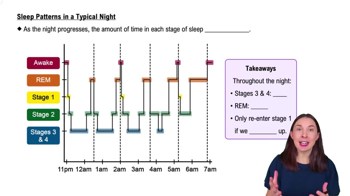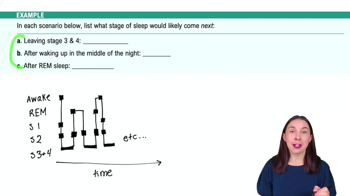Table of contents
- 1. Introduction to Psychology1h 43m
- 2. Psychology Research2h 20m
- 3. Biological Psychology2h 41m
- 4. Sensation and Perception28m
- 5. Consciousness and Sleep32m
- 6. Learning41m
- 7. Memory34m
- 8. Cognition37m
- 9. Emotion and Motivation35m
- 10. Developmental Psychology33m
- 11. Personality48m
- 12. Social Psychology41m
- 13. Stress and Health41m
- 14. Psychological Disorders44m
- 15. Treatment47m
5. Consciousness and Sleep
Sleep
Struggling with Psychology?
Join thousands of students who trust us to help them ace their exams!Watch the first videoMultiple Choice
Janice is dreaming about walking her dog. However, in her dream, her dog is flying, the sidewalk is moving, and she has no awareness that this activity is odd. Janice is probably in _____ sleep.
A
REM
B
Stage 1 of non-REM
C
Stage 2 of non-REM
D
Stage 4 of non-REM
 Verified step by step guidance
Verified step by step guidance1
Understand the characteristics of REM sleep: REM (Rapid Eye Movement) sleep is a stage of sleep where dreaming is most vivid and bizarre, often involving unusual scenarios that seem normal to the dreamer.
Recognize the lack of awareness in dreams: During REM sleep, individuals typically experience a lack of awareness that the dream content is odd or unrealistic, which aligns with Janice's experience.
Differentiate REM sleep from non-REM stages: Non-REM sleep stages (Stage 1, Stage 2, Stage 4) are generally associated with less vivid dreaming and more realistic scenarios.
Consider the physiological aspects of REM sleep: REM sleep is characterized by rapid eye movements, increased brain activity, and temporary muscle paralysis, which allows for vivid dreaming without physical movement.
Conclude that Janice's dream characteristics align with REM sleep: Given the flying dog and moving sidewalk, Janice's dream fits the profile of REM sleep, where bizarre and vivid dreams occur.

 3:25m
3:25mWatch next
Master Circadian Rhythms with a bite sized video explanation from Hannah Gordils
Start learningRelated Videos
Related Practice


































































































![Race, Genes and IQ Differences | Bret Weinstein [Mini Clip]](https://img.youtube.com/vi/IztL_m3pd70/mqdefault.jpg)



































































































